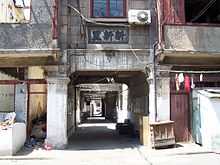Longtang

The longtang (弄堂 lòngtang, Shanghainese: longdang) is a traditional urban alley-community in Shanghai.[1] It is sometimes called lilong (里弄) and is often indicated by alley addresses ending -li. The Shanghai longdang is loosely equivalent to the hutong, a Mongolian word, in Beijing. As with the term hutong, the Shanghai lòngtang can either refers to the lane that connects the houses, or a group of houses connected by the lane.[2][3][4][5]
Use of "-lòng" in addresses

On its own lòng (traditional Chinese 衖, simplified Chinese 弄) is a Chinese term for "alley," which is often left untranslated in Chinese addresses. The names of many longs are associated with past business associations, for example Jiangyuan Long (Alley of the Sauce and Pickle Shop).[6] The address format is typically as seen in an address like "No.4, Long-20, Jing'an District, Shanghai" - Shanghai shi, Jingan qu, 20-long, 4-hao. In simplified Chinese confusion is sometimes caused between lòng ("alley" traditional Chinese衖) with the verb nòng (meaning "tamper with" traditional Chinese 挵) since both have been simplified down to "弄" by removal of the bù radical (a hand-radical shǒu-bù 扌 in the case of "tamper with", a walk-radical compounded from chì彳 "step" and chì 彳 "step" on both sides of the phonetic共 "public" in the case of "alley"). In simplified Chinese the two characters are now written the same way, but the two different pronunciations are still retained in standard Beijing Chinese, where only context indicates whether to read lòng or nòng. However in Shanghai dialect the alley is also pronounced nong.
See also
References
- ↑ Frommer's Shanghai Day By Day - Page 162 Graham Bond - 2011 1912 "1917 China's first shopping mall, the Sincere Department Store, Lilong, or Longtang Li means “neighborhood,” and long means “alley.”"
- ↑ Walking between slums and skyscrapers: illusions of open space in ... - Page 160 Tsung-yi Michelle Huang - 2004 "Shanghainese call lilong, their characteristic residential design, as longtang. "Long" means alley or lane and "tang" parlor or hall. "All houses are facing the lanes and lanes become the public space used by all residents. Enclosed, the whole ...
- ↑ Postsocialism and Cultural Politics: China in the Last Decade of ... - Page 196 Xudong Zhang - 2008 "As long means a lane and tang the front room of a house, longtang either refers to a lane that connects houses or a group of houses connected by lanes. Longtang however might not be so explicit as lilong for the li in lilong means ..."
- ↑ Narrating Architecture: A Retrospective Anthology Page 474 James Madge, Andrew Peckham - 2006 "Four sketches by Feng Zikai of Shanghai's alley life: clockwise from top left: lowering a basket down to the alley to purchase ... these activities were certainly not considered in the original design of the lilong, but were gradually introduced in the practice of everyday life within the community. A local writer, Shen Shanzeng, has named this special way of living as 'life in the alley' (long-tang ren-sheng)."
- ↑ Cities Surround The Countryside: Urban Aesthetics in Postsocialist ... - Page 320 Robin Visser - 2010 "Chunlan Zhao refers to the generalization that Shanghai without its longtang is no longer Shanghai, in From ... archway; li means neighborhood; long (or nong, in Shanghai dialect) means alley. ... The earliest lilong compound resembled the lifang residential ward in imperial capitals, but instead of being enclosed by ..."
- ↑ Hanchao Lu -Beyond the Neon Lights: Everyday Shanghai Early 20th Century Page 438 1999 "See also Soy sauce stores Jiangyuan Long (Alley of the Sauce and Pickle Shop), 238, 3/8n149 Jianye Li (Alley of Establishing Careers), 148 fig.
| Wikimedia Commons has media related to Lilong. |